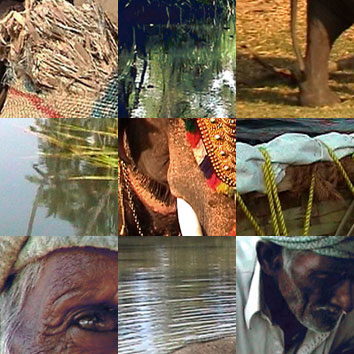


ELEFANTASY
I got the idea for Elefantasy in 1999. I saw before me the large body of an elephant that you could climb on and sit in, and a film journey to a country where elephants live in the wild. The work was completed and shown late in 2002.
This work deals with the creative process, and the concept involves several layers. When I was on the way to the airport in Cochin to return home, the taxi driver asked for my name. Anna, I replied, and he started to laugh. Anna means elephant in Malayalam, he said. (Malayalam is the language spoken in Kerala in southern India). Am I trying to deconstruct and recreate myself?
To construct the elephant body I started with a number of drawings and studies in clay of elephants that gradually became simpler in form. I wanted to have a body that related to larger architectural spaces. I chose a scale that enabled the sculpture to be dismantled, transported and rebuilt in new surroundings (height 2.70 metres, length 2.75 and width 2.00). I decided on using birch plywood. My model was done in a scale of 1:15. In working with it my form developed into a hybrid of design, architecture and organic body.
The other part of this work is the journey to a country where elephants live in the wild. In the choice between the African and the Indian elephant, I settled for the latter. In India the elephant has from time immemorial been a strong symbol. Ganesha, the Hindu elephant god, has a prominent role in folklore and religion. The Indian elephant has been used as a labour animal but is also seen in temples and religious ceremonies. To this day, elaborately decorated elephants are great attractions in religious processions, which I saw in a village north of Cochin.
Elephanta outside Bombay is an underground temple site cut directly into the rock. Shiva is the central god portrayed here. Shiva (Sanskrit: “Auspicious One”) is one of the most complex gods of India, combining seemingly contradictory qualities. He is the destroyer as well as the restorer, the great ascetic as well as the symbol of sensuality. In Elephanta the three-headed Shiva shows his attributes: creator, preserver and destroyer. Aren’t these three a symbol for the forces one has to wrestle with when creating?
The Portuguese named Elephanta after a large sculpture of an elephant originally found at the entrance of the temple. Ganesha the Elephant God is often found at entrances of temples and other buildings. He is the son of Shiva and Parvati and is said to remove obstacles. Therefore he is the first god to be invoked in worship or in the undertaking of new enterprise. Ganesha is also the special patron of letters and learning, and is the legendary scribe of Mahabharata, one of India’s foremost epics.
I saw wild elephants in national parks in the foothills of the Nilgiri Mountains. One tends to believe that elephants move clumsily. In fact they move very smoothly, almost as if flowing. On one occasion we stood eye to eye with a matriarch elephant. She flapped her ears and scraped her foot on the ground before turning around and following her fleeing flock. It is said that elephants have very good memories. They are still hunted illegally for their ivory, and they sometimes attack and kill people in India. But it was moving to see the tamed elephants being scrubbed and bathed by their warders, the mahouts. The interplay between this large, docile and strong animal and the tiny human being was extraordinary to see. When an elephant obeys a warder’s orders, its reactions are infinitely slower than those of the comparatively restless human.
Translated into English by Finn Printz-Påhlson. Edited for the web by Anna Bring and Laura Agustin.
To see the film shown at the exhibition, press VIDEO and choose from the list.
